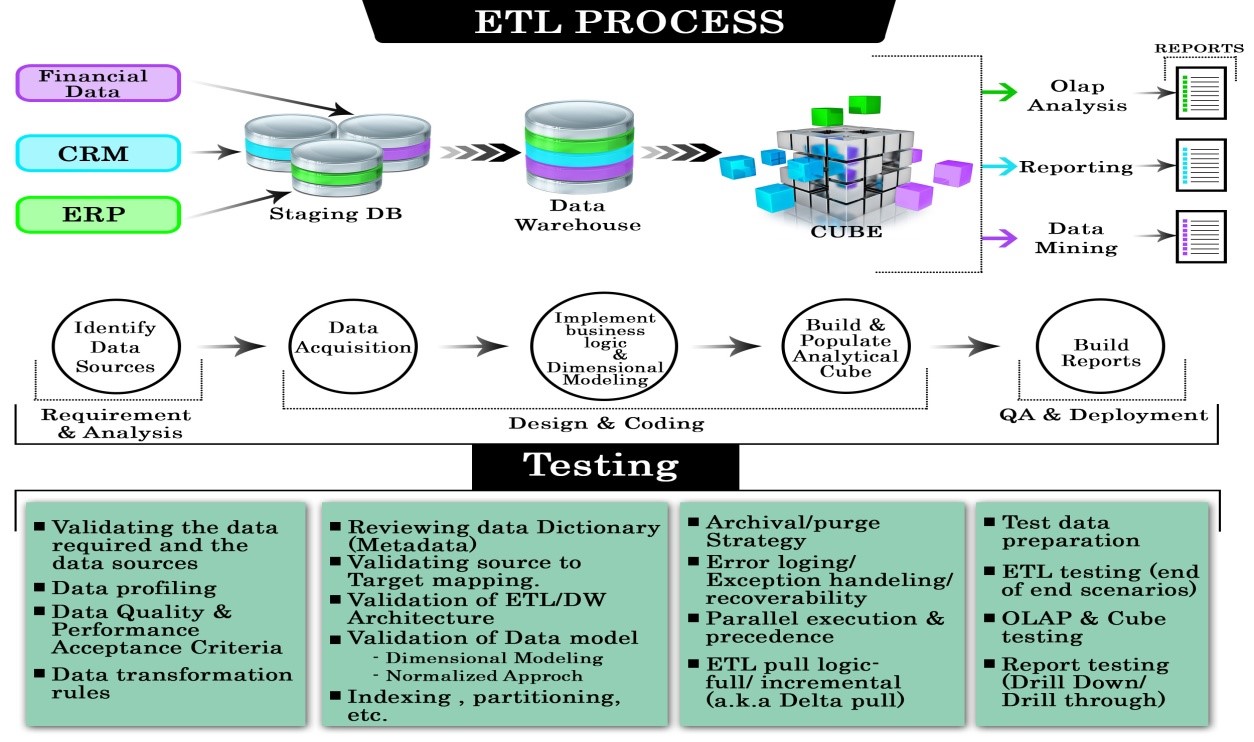Why You Need ETL Testing and What You Need to Know
|
Listen on the go!
|
The Importance of Data
Data quality is the key to business success. Bad data leads to inaccurate information that could incur a great loss, which in turn could potentially lead to business failure. To avoid this, data needs to be processed and transformed into quality information that must be reported to the right people at the right time.
Put simply, good data provides insight. Armed with this, businesses can improve their day-to-day decisions. This isn’t just for management; it applies to every level, from the ground to the top. However, data is rarely useful in its raw state; it must be processed and presented in a way that works at the respective levelto be utilized appropriately.
If data accuracy is low at the beginning of the process, it leads to a lack of insight, and hence, the decisions it influences are also likely to be poor. Therefore, organizations must realize the criticality of data and understand that quality is more important than quantity. Most people prioritize only gathering information without giving importance to its accuracy and whether/how it could be used for further processing.
Organizations that obtain the most significant ROI measure the impact of poor-quality data and the benefits of having improved and enhanced data. Metrics range from shorter processing time, reduced hardware costs, shorter sales cycles, accurate analytics, reduced telemarketing costs, increased return on existing technology investments (such as ETL applications), higher cross-sell and up-sell volumes, and other benefits of improved data quality.
What is ETL Testing
ETL stands for Extract, Transform, and Load data. It is predominantly done using standard software tools available on the market, such as Informatica, Ab Initio, Datastage, OWB, SSIS, etc. These tools help build, manage, and maintain the integrated/migrated data.
Extract
Extract is the process of extracting the desired data from different homogenous or heterogenous data sources (databases/applications).
Transform
The extracted data is then transformed into the required format or structure according to business needs. This process can happen in a separate staging environment. Depending on business needs, the transformation can be basic or advanced.
- Basic Transformation: Data is subjected to cleaning, Scrubbing, duplication, Format revision, and key restructuring.
- Advanced Transformation: Data is subjected to Filtering, Joining, Splitting, Sorting, Transposing, Aggregation, Summarization, Derivation, and Integration.
Load
Finally, the transformed data is loaded into the target destination, such as databases or data warehouses, in one full load or incremental mode per business requirements.
Need for ETL Testing
Transportation of data from extraction to loading could result in human or system errors, resulting in poor information conveyed across the enterprise. ETL testing ensures that such errors do not occur and eliminates/mitigates the bugs based on the following strategies:
- Data Completeness
- Data Correctness
- Data Integrity
- Data Reconciliation
- Data Transformation
- Data Quality
- Performance and scalability of the system
List of tests performed:
- Unit testing
- System testing
- System Integration testing
- Regression testing
- Performance testing
- User acceptance testing
Challenges Faced by Testers in ETL/Data warehouse Projects
Usually, testers in ETL/data warehouse projects face the following challenges:
- Frequent changes to requirements
- Availability of source data only for a certain period
- No access to ETL tools or their code
- Unavailability of source to target mapping documents
- More response time required by SQL query
- Verifying and validating data comes from different sources with varied formats and structures
- Unstable testing environments
- Huge volume of data to test
The StrategicApproach of Cigniti to Help in Data-centric projects
Cigniti Technologies understands that accurate data is the key to making important business decisions. Hence, Cigniti has helped many clients in the Banking, Finance, Insurance, and Retail domains to achieve 100% data quality. We identify bugs, perform root cause analysis, and report them early in SDLC to reduce costs and time. Before getting into ETL testing, we inspect the different systems, their models, processes, and business requirements to determine any inconsistencies or ambiguities. We perform data profiling/data mining to understand the trends and patterns of data better and identify any source data bugs.
Data warehouse Testing
We compare data from different data sources with different formats/structures to the target systems per the business rule. On relational databases, we run extensive SQL queries on huge volumes (terabytes) of data to identify the data anomalies.
- Data Checksum – Source to Target Counts
- Source to Target data testing
- Target to Source data testing
Business Intelligence Reports
We test reports generated by Cognos, Micro strategy, Tableau, SSRS, SAS, Crystal Reports, Pentaho, and SAP BO for accuracy, hierarchy, granularity, security, and performance.
We at Cigniti Technologies understand how a poorly written SQL query can damage databases and degrade their performance. Keeping that in mind, we analyze queries, tune them to achieve accurate results with less response time, and propose ideas to eliminate bottlenecks in database performance.
We have helped our clients in –
- Maintaining and managing the data warehouses/DataMarts throughout their operational cycle and
- Deploying automated data warehouse/DataMart testing processes to reduce manual testing efforts.
Cigniti Technologies takes pride in offeringits clients in-depth ETL testing services. Cigniti’s ETL Testing processes and frameworks are designed to guarantee high-speed and accurate results, with the ability to reuse indexes for its components as high as 70%. Cigniti works with the client’s team to understand, analyze, plan, design, execute, document, and roll out a future-ready test strategy that saves time and ensures a faster time to market.




Leave a Reply